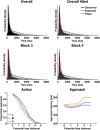The cognitive architecture of anxiety-like behavioral inhibition
- PMID: 27797550
- PMCID: PMC5178866
- DOI: 10.1037/xhp0000282
The cognitive architecture of anxiety-like behavioral inhibition
Abstract
The combination of reward and potential threat is termed approach/avoidance conflict and elicits specific behaviors, including passive avoidance and behavioral inhibition (BI). Anxiety-relieving drugs reduce these behaviors, and a rich psychological literature has addressed how personality traits dominated by BI predispose for anxiety disorders. Yet, a formal understanding of the cognitive inference and planning processes underlying anxiety-like BI is lacking. Here, we present and empirically test such formalization in the terminology of reinforcement learning. We capitalize on a human computer game in which participants collect sequentially appearing monetary tokens while under threat of virtual "predation." First, we demonstrate that humans modulate BI according to experienced consequences. This suggests an instrumental implementation of BI generation rather than a Pavlovian mechanism that is agnostic about action outcomes. Second, an internal model that would make BI adaptive is expressed in an independent task that involves no threat. The existence of such internal model is a necessary condition to conclude that BI is under model-based control. These findings relate a plethora of human and nonhuman observations on BI to reinforcement learning theory, and crucially constrain the quest for its neural implementation. (PsycINFO Database Record
(c) 2016 APA, all rights reserved).
Figures



References
MeSH terms
Grants and funding
LinkOut - more resources
Full Text Sources
Other Literature Sources
Medical

